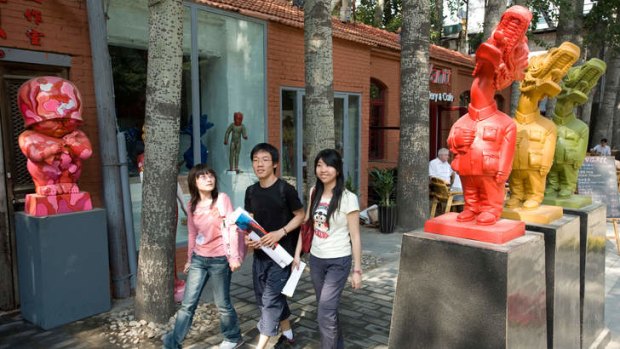
Wandering among the street art in Beijing's 798 Art District.Credit: Alamy
Natasha Dragun revels in the transformation of Beijing's former manufacturing hub into a creative hotspot.
The first time I visited Beijing's 798 Art District in 2002, I spent two hours getting there in a smoke-filled taxi, my driver - completely lost - stopping every five minutes to ask directions from bemused locals who had no idea what he was talking about. "Too hard, too hard," he mumbled between cigarettes. We eventually stumbled upon the neighbourhood of grey-brick Bauhaus-style buildings and I spotted a sign for the Beijing Tokyo Art Project, the first gallery to open in the neighbourhood. Back then, it had just a handful of artists' studios and the trendsetting Timezone 8 Art Books to keep it company.
The next time I visited, just a year later, I was dressed in costume and working behind the bar at a high-octane New Year's Eve party, held in the cavernous 798 Space. Expats and locals slouched between disused 1950s factory equipment painted emerald-green, oblivious to the lipstick-red Maoist slogans painted on the walls above, under swooping arched ceilings.
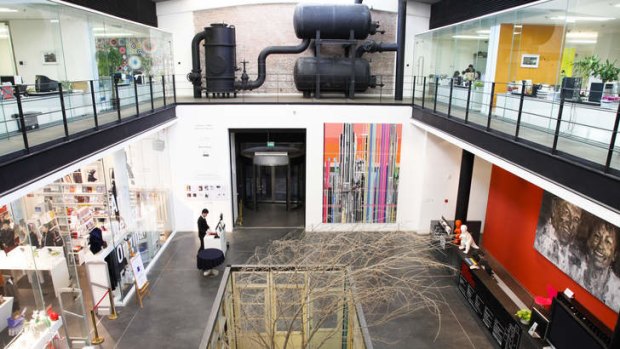
The Ullens Centre for Contemporary Art.Credit: UCCA
From then until 2008 when I left Beijing, I visited the area dozens of times, to shop in hip boutiques, to peruse art books, to chat to young designers and artists, to hang out in cool cafes, to dance in the latest clubs, to check out cutting-edge exhibitions. Earlier this year I returned and was even able to check into a hotel, the Grace Beijing now part of the precinct and fitted out with candy-coloured furniture and paintings by China's best and brightest. And getting there was a breeze. My taxi driver gave be a big thumbs-up when I mentioned "qi-jiu-ba" (7-9-8) and even chatted to me about China's top artists.
Today, millions of tourists and students descend on the neighbourhood, set north-east of Beijing and occupied by communist-era East German military factories and warehouses. In their heyday, the buildings were packed with labourers churning out equipment that would be used in the construction of the Workers' Stadium and Great Hall of the People, as well as loudspeakers for Tiananmen Square - Deng Xiaoping, Jiang Zemin and Kim Il-Sung were among the notable guests who stopped by to check on production. But the area came under pressure during Xiaoping's reforms of the 1980s, and the factories were eventually decommissioned in the early 1990s, lying empty for years.
The area's revitalisation began in 2000 when the city's artist community relocated there, lured by cheap rent and lofty, light-filled spaces. By 2003 there were 30 studios open, with more than 200 people on the waiting list to get in. Among the pioneers were designer Huang Rui and hutong photographer Xu Yong, who opened the 798 Space gallery in 2002. (Huang belonged to a group of avant-garde artists known as xingxing, "stars", censured at the end of the 1970s. In the mid-1980s he followed the trail of many Chinese artists and took refuge in Japan, only to return to China in the late '90s). The #6 Sichuan restaurant followed, occupying a former canteen, and the Dashanzi Art Festival launched in 2004, bringing with it international media attention and tens of thousands of curious visitors.
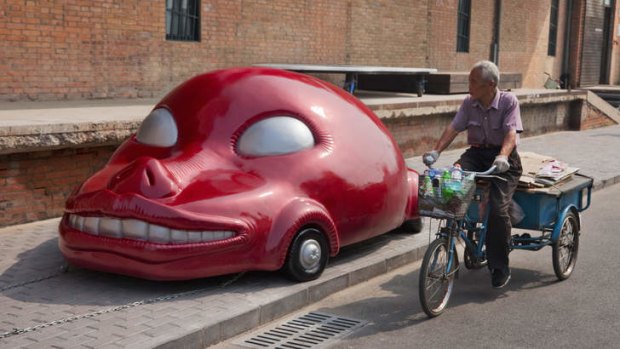
A footpath installation.Credit: Getty Images
"Beijing has been leading the Chinese art market in terms of the number of galleries and the amount of sales - at fairs, privately and at auction," says Tom Pattinson, the30-something founder and director of SURGE Art, the largest company promoting emerging art in China. "Beijing's art world is the most accessible and there are a great number of very good galleries."
The current roster of more than 50 foreign and Chinese galleries at 798 Art District includes the Long March Space, with evocative exhibitions dedicated to upcoming contemporary artists; Chinese Contemporary Gallery, taking its cues from its older sister in London; the 798 Photo Gallery, the first of its kind in China; the Ullens Centre for Contemporary Art, one of China's most important not-for-profit art centres, hosting exhibitions as well as art talks, film screenings, performances and workshops; and Pace Beijing, representing dozens of cutting-edge contemporary artists.
The creativity spills outside as well, with colourful murals decorating tired brick walls, and modern interpretations of terracotta warriors. In between shows the spaces host product launches and parties for the who's who of the design world - Sony and Dior among them.
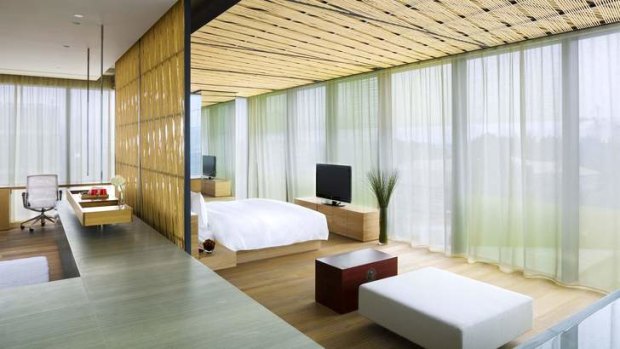
A penthouse room at Beijing hotel The Opposite House.
Indeed, the neighbourhood has come so far from its proletariat roots that many artists have been forced to move out, unable to afford soaring rents; some have relocated to Caochangdi, just north of 798 and home to a surprising collection of emerging galleries and studios, and Heiqiao Art District, also nearby.
You can easily spend a day strolling between the different spaces at 798 - most of them free. But if you're looking for insights, it's a good idea to join a tour.
Pattinson leads customised visits to the neighbourhood with Bespoke Beijing, a tour company that creates upscale programs for tourists and locals looking to dig a little deeper into Chinese culture.
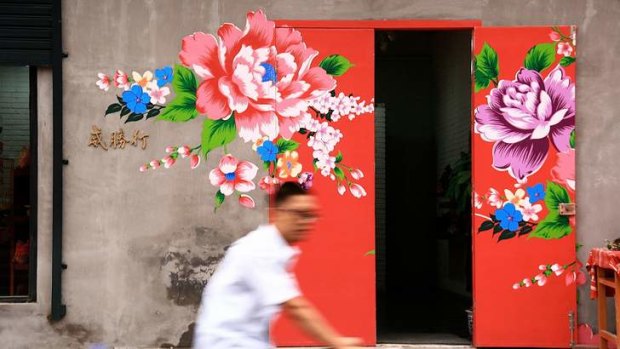
Floral graffiti adorns a doorway.Credit: Getty Images
Each tour is different, but might begin with an historical look at the area and of the contemporary art in China, followed by visits to both well-established and avant-garde galleries and even studios. "If you're interested in the history of contemporary art we might visit Huang Rui's studio," says Pattinson.
And more and more people are interested in purchasing pieces. In 2011-12, five of the top 10 contemporary artists in the world came from the Middle Kingdom, as did three of the world's top earners from art. China now accounts for 90 per cent of the Asian art market and generated some €109 million (about $160 million) more from contemporary art than the United States from approximately the same number of works sold. And Beijing is now home to one of the largest auction houses in the world.
"The first and most important thing when buying Chinese art is that you like it," says Pattinson. "It should be something that you want to look at every day. Li Jinguo is one of my favourite artists at the moment. A student of the world-famous Sui Jianguo, Li's well-crafted sculptures are often very humorous, but with sometimes dark undertones."
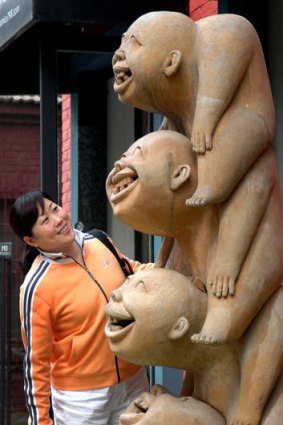
A tourist shares smiles with a sculpture.Credit: Corbis
While the market may seem flooded and inflated - at auction recently, Zhang Xiaogang's 1988 triptych, Forever Lasting Love, sold for a record $HK79 million ($11 million) - Pattinson is quick to reassure there's still a lot of affordable Chinese art out there, and that the scene still has great potential for growth.
"China has been represented at the Venice Biennale for 20 years, but it is only recently that the Chinese artists are being regarded as quality international artists rather than political artists or exotic artists. They are already doing some great things with video art, installation and graphic and digital arts. It's only going to get bigger and better."
The writer was a guest of Swire Hotels and Cathay Pacific.
THREE OTHER CHINESE ART DISTRICTS WORTH VISITING
SHANGHAI'S 50 Mongshan Road art precinct also began its life as a collection of old warehouses and is now home to dozens of top galleries including Art Scene Warehouse and ShanghART.
In GUANGZHOU'S Haizhu district, the T.I.T Creative Garden is a series of disused factories transformed into studios and gallery spaces for creative companies. Top fashion designer Liu Yang recently moved his studio into the area.
CHENGDU'S East Music Park is Southwest China's answer to Beijing's 798 Art District. The neighbourhood is also popular for its cafes, live music venues and boutiques.
THREE MORE BEIJING CULTURAL DISTRICTS
WEIWEI LIVING
With rents rising in the 798 Art District, many of Beijing's artists are looking to relocate to up-and-coming creative neighbourhoods. In Beijing's northeast, the Caochangdi Art District is home to dozens of artist studios and galleries set in converted industrial military buildings, many of them designed by acclaimed - and somewhat controversial - architect and contemporary artist Ai Weiwei. Also one of the forces behind the Beijing National Stadium, Ai still spends a lot of his time working from his studio here, enveloped by more than 10 gallery spaces including non-profit Taikang Space and Three Shadows Photography Art Centre.
BEYOND AVANT-GARDE
The Songzhuang colony has developed as a hub for up-and-coming artists, and it's now home to more than 1000 artists. Although initially dedicated to avant-garde art, the neighbourhood is today a mix of sculptors, photographers, painters and new-media artists - plus a few dreamers hanging on to the communal artistic lifestyle that the area nurtures.
HEIQIAO TOURS
Not far from the 798 Art District, Heiqiao also attracts emerging artists, with large warehouses transformed into studios and art spaces. The Ullens Centre for Contemporary Art in 798 offers tours with a twist to Heiqiao - book in and you'll be invited to visit the studios of three local artists, Yu Fan, Ye Nan and Guo Hongwei.
TRIP NOTES
MORE INFORMATION
GETTING THERE
Cathay Pacific operates daily flights from Australia to Beijing via Hong Kong. Phone 13 17 47, see cathaypacific.com.
STAYING THERE
Trendsetting Opposite House was one of Beijing's first boutique hotels, designed by Japanese architect Kengo Kuma and with 99 blonde-wood rooms and studios featuring complimentary minibar snacks and Wi-Fi and organic Tibetan amenities. The soaring lobby hosts contemporary art exhibitions that might include installations by Gao Xiaowu or Li Xiaofeng. See theoppositehouse.com.
Part of the 798 Art District, the Grace Beijing offers 30 individually designed rooms featuring contemporary art and replica Ming-dynasty furniture in bold colours: canary yellow, lime green and azure. Gaze out your window and you'll spot larger-than-life laughing men sculptures by Yue Minjun or graffiti murals. See gracebeijing.com.
TOURING THERE
SURGE Art founder Tom Pattinson leads customised 798 Art District tours with Bespoke Beijing. See bespoke-beijing.com, surgeart.com.
Sign up for the Traveller Deals newsletter
Get exclusive travel deals delivered straight to your inbox. Sign up now.